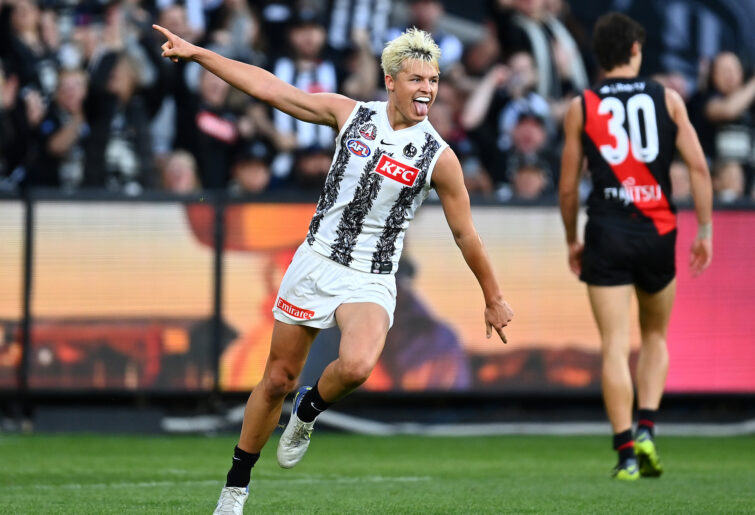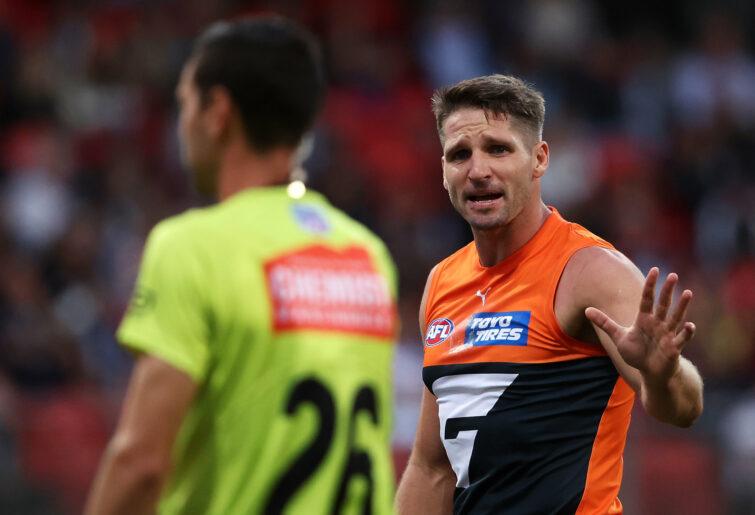I am so sick of watching deplorably umpired games.
The footballing fraternity has always qualified umpiring as such a hard job, that a few mistakes are to be expected.
How about instead of making excuses, we start looking at the cause?
The AFL.
Interpretations change so drastically that we never know what we’re going to get from quarter to quarter, let alone game to game, week to week, or even year to year.
Several interpretations are broken for a variety of reasons, and instead of having the courage to address the issue, the AFL will just stonewall the footballing public until these aberrations devolve into novelties, like ruck contests that yield inexplicable frees.
Here are the worst of the current interpretations.
Ducking – the Jack Ginnivan rule
I don’t deny that Ginnivan would duck on occasion – just like any other footballer – but the rationalisations espoused to abrogate the unavoidable body mechanics and put the blame solely on Ginnivan’s willfulness are absurd.
Last week, in the Collingwood-Sydney game, Ginnivan had his head ripped off and was not awarded a free kick. The justification was that he leaned into the tackle and then lifted the arm to drive contact high.
Really?
Ginnivan was in motion picking up the ball. He was trying to propel himself forward out of the contest. Naturally, his body will be leaning forward. Are we expected to believe that Ginnivan (or any other player in this situation after just picking up the ball) is meant to spring up like a Jack-in-a-Box while in full motion?

(Photo by Quinn Rooney/Getty Images)
Then there’s criticism that he lifted his arm to drive contact high – this is how players break tackles. They flap the arm to shrug contact. He would be negligent if he didn’t try.
Yet these are the misnomers that the AFL and their defenders are perpetuating to justify why these frees are not being given to some, but not to others.
Consistency, anybody?
The sling tackle
About a month ago, we had a spate of reports for sling tackles. The two biggest were Collingwood’s Taylor Adams and Essendon’s Zach Merrett the week before the Anzac Day game.
The most ferocious of these sling tackles – Melbourne’s Clayton Oliver on Sydney’s Jeff Sparrow – wasn’t cited. The reason? Sparrow’s head didn’t hit the ground.
The beauty of this idiocy is that it’s wrong on two counts.
The AFL is all about protecting the head and potential concussion. The head does not need to be impacted to cause concussion. The whiplash motion can cause concussion. So, in this case, Sparrow’s head not hitting the ground is a furphy.
But the greater reality is if you don’t want players to sling tackle, then you penalise every sling tackle, rather than qualify it as a lottery that it’s only applicable if the ball carrier’s head hits the ground.
Whyever the AFL would purposely introduce a grey area is beyond any reason.
Deliberate
So any time a player kicks the ball and it goes out of bounds without a teammate in the immediate vicinity, well, that must be deliberate, regardless of the distance the ball has travelled or whatever peculiar bounces it might’ve taken.
If this is the way this rule is going to be umpired, then the AFL might as well penalise the team who’s touched it last, regardless of intent. Of course, what we now see is opponents meekly following the ball’s course in anticipation of a deliberate.
Meanwhile, we see players paddle the ball out, or step over the line rather than face pressure.
How are these any different?
Dropping the ball/holding the ball
Prior opportunity has broken a rule that was once clear. In another era, if a player wrongly disposed of the ball – if they dropped it, or threw it, or tried to kick it but it missed their foot – it was incorrect disposal and the player was pinged.
Conversely, if the ball was held to a player and it was physically impossible for them to dispose of the ball, the umpire would arbitrate that the ball was held to the player, and it was time for a ball-up.
But now if a player hasn’t had prior opportunity, they can drop it or throw it and it’s fine. “No prior.” That’s what we hear. But if a player has had prior opportunity, and they’re tackled and it’s held to them, then it’s holding the ball.
We have polarised the legitimate interpretations.
What’s worse now are things that are considered prior opportunity, such as ducking, or trying to fend off an opponent.
While the logic is understandable – a player has tried to break clear of an opponent rather than dispose of the ball – the truth is sometimes the ball carrier is just trying to find a bit of space rather than panic-dispose of it and turning it over or, worse, panic-dispose of it with the risk of it going out of bounds and it being called deliberate.
This rule needs to get back to its most fundamental truth: if the ball is not legally disposed of by hand or foot, then it is incorrect disposal.
Surely there’s a happier medium to be deciphered from this mess than what we see today.
Push in the back
Remember this? If a player pushed an opponent in the back in any way and took them out of the contest, then it was considered push in the back.
Funnily, or sadly, some people believe a player can push as long as they don’t use their hands. This interpretation is residue from the misguided “hands in the back” rule when a player couldn’t even place a hand on an opponent’s back. You even hear commentators misinterpret the rule by citing a player hasn’t used their hands for the push.
The rule is simply that a player cannot push an opponent in the back regardless of how they do it.
Coincidentally, this round we’ve seen some absolute howlers ignored.
The stand rule
This is one of the worst rules the AFL has ever introduced. While some will argue about how it’s improved the aesthetics of the game, it’s just plain wrong to prohibit the player on the mark from moving, allowing the ball carrier to gallivant away unpressured.
This rule wasn’t introduced because this was an issue in the game – it wasn’t like players on the mark were encroaching or finding an unfair advantage to pressure the ball carrier.
It was introduced simply to give the ball carrier an opportunity to run off unimpeded, thus keeping the ball moving.
We even see players on the mark penalised if they step backwards – where they’re not impacting the ball carrier.
Surely some common sense should apply to this rule as a practice.
Dissent
I appreciate that we don’t want players criticising decisions, or ripping into umpires, but surely we must allow players to be human and to vent frustration in the heat of the moment, or to query a decision if they’re unclear on it.

Jesse Hogan of the Giants appeals to the umpire. (Photo by Mark Kolbe/Getty Images)
Again, there’s so much grey in this interpretation. When is it dissent and when isn’t it? A player can’t throw their arms up in exasperation, but when a player has kicked the ball toward the line (for a deliberate), four opponents can turn and throw their arms up in the air like they’re a slips cordon appealing for a wicket.
Sure, let’s respect the chain of authority and protect the umpire from abuse but, equally, let’s allow the players to be human.
Keeping an eye on the ball in a marking contest
The AFL’s about safety yet champion this rule: a player must keep their eye on the ball in a marking contest. If they don’t, well, it shows that the ball isn’t exclusively their focus, so they must be up to something. God forbid that we allow a player backing into a pack, or running with the flight of the ball, the opportunity to check what they’re running into. Instead, we expect them to blindly contest the ball at the risk of their own safety
Others to look out for
The umpires are calling “play on” more often now when they deem a kick hasn’t gone long enough to constitute a mark; the absurdity behind this has been the inconsistency – they’ll ignore three, and then call one that seemed longer than the rest.
In the Collingwood-Sydney game, the umpire called a Jamie Elliott kick to Josh Daicos as not going the required distance; Daicos then kicked it straight back to Elliott, and that was fine. How? How is that possible? It’s the same kick forward and back.
We’re also seeing umpires calling “play on” quicker after a mark or a free kick – a player will be bouncing back to his spot, only to suddenly be called to play on.
The AFL’s all about keeping the ball moving to avoid the risk of ugly packs congregating. That’s why the interpretation of deliberate has been strengthened, why players have less and less time before “play on” is called after a mark or a free, why players can kick straight out after a behind.
Keep that ball in motion.
Solutions
Several weeks ago, the football media roundly condemned the umpiring in the Adelaide-Collingwood game. People like Gerard Whateley and Andy Maher even criticised how poor it was. The AFL then came out and admitted one wrong decision had been made. That was it.
This is typical in the footballing landscape – we get bad decisions, and the AFL will just about always find a way to qualify the bulk of them. Why will umpires get better when there is no genuine accountability?
I appreciate the AFL don’t want umpires publicly lambasted because it discourages others from taking it up as a profession. But surely it’s time the umpires were made professional, and – as an inducement – paid obscenely to encourage others to take up the profession.
Also, if umpires were full-time, they could do clinics at schools and events and humanise them to the next generation and beyond. Most importantly, it would give the AFL and their umpires time throughout the week to study rules and interpretations so we find a way to develop consistency through the ranks and make rules as concrete as humanly possible, rather than malleable and subject to whim.
Instead, we get a hodgepodge. We all know we do. Too many frees paid in the Friday night game? Well, we know we’ll get fewer paid in the next game. Push in the backs ignored? Well, they’ll start paying them next.
Game is tight? As the adage goes, they’ll put the whistle away.
As for the interpretations within a game? Well, there’s four umpires now, so the likelihood of inconsistency is better than ever. Umpiring is so often such a reactionary exercise that it remains the biggest unsung frustration in a billion-dollar industry.






























































































